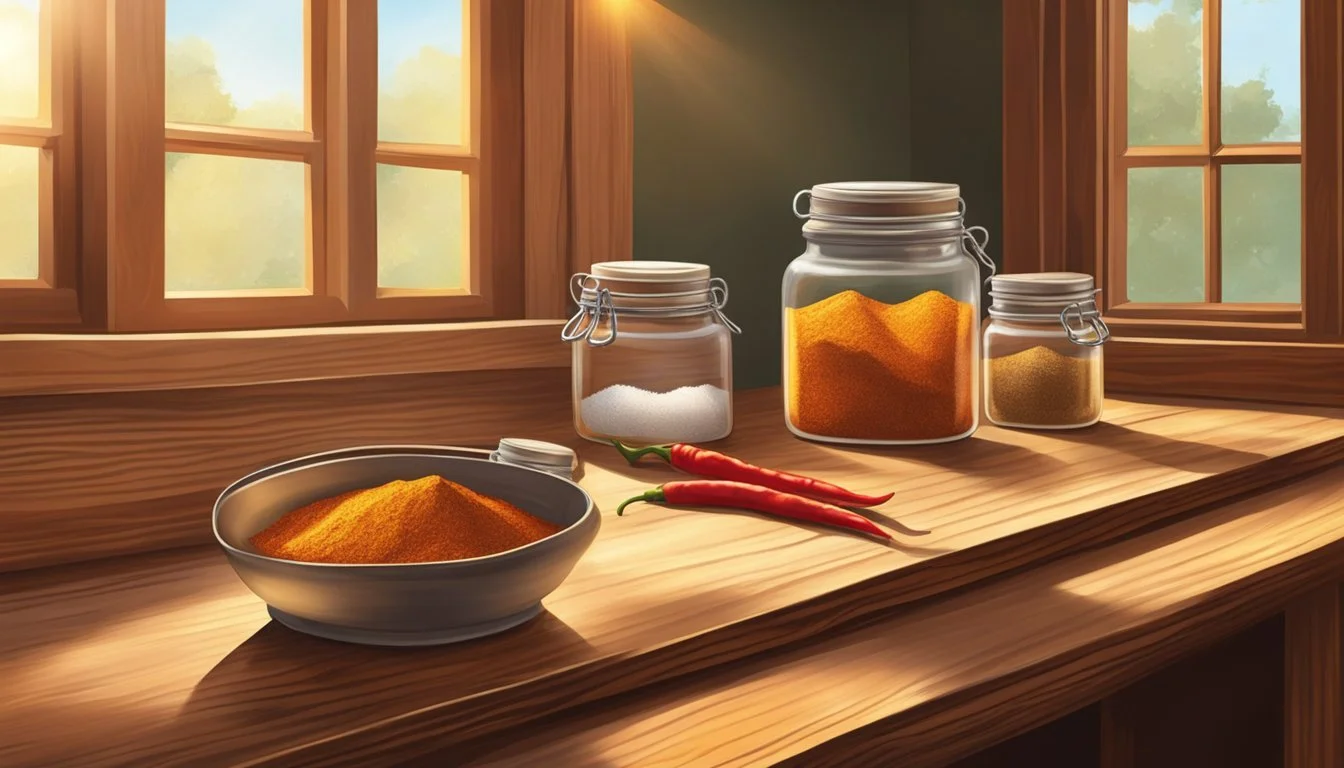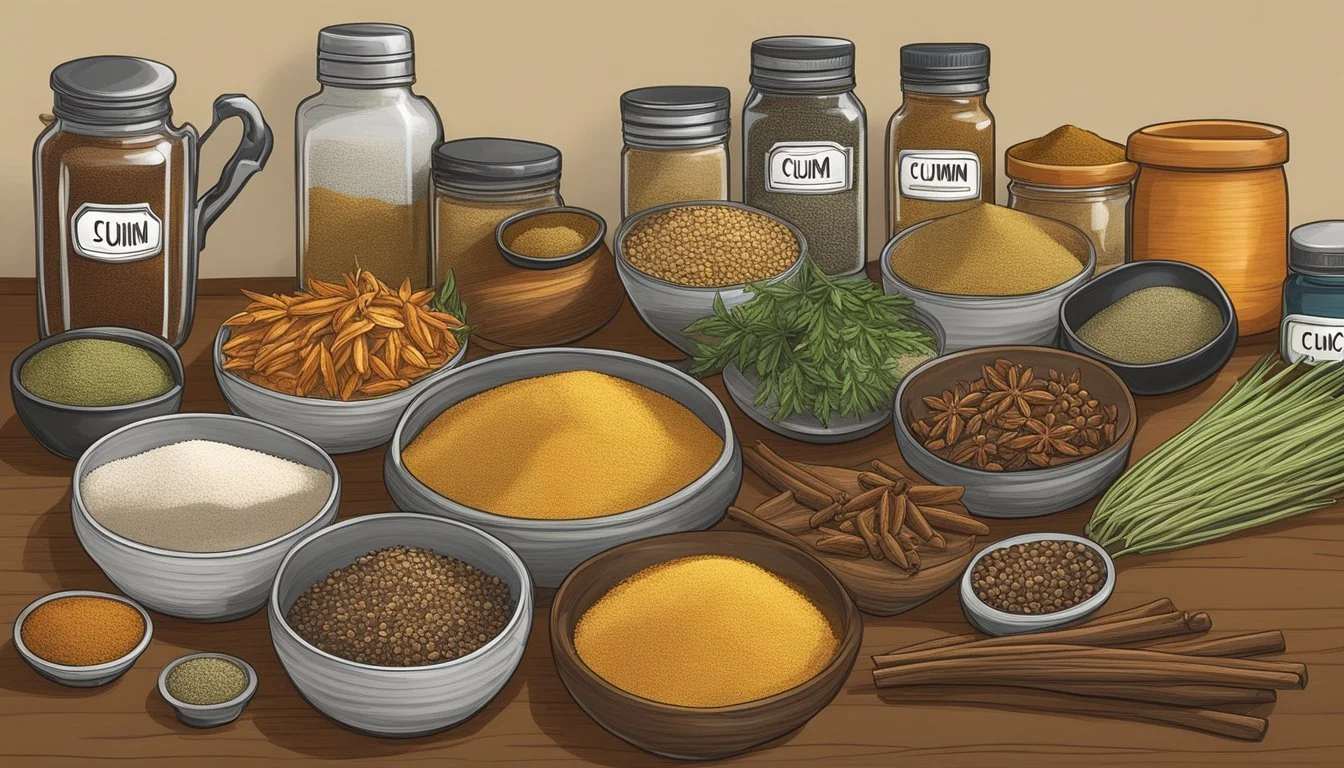5 Essential Spices in Texas Cooking
A Flavor-Packed Guide
Texas cooking boasts a rich heritage influenced by a medley of cultures and flavors. Central to the authenticity of Texan cuisine are its vibrant and essential spices that infuse each dish with its distinctive taste. Understanding these core spices is key to unlocking the true essence of Texas culinary traditions.
The utilization of specific spices not only defines the flavor profiles but also honors the diverse influences on Texas food—from Mexican to Southern and beyond. Cooking with these essential spices offers a genuine taste of the bold and hearty spirit emblematic of the Lone Star State. This article aims to highlight the indispensable spices that every Texan cook should keep in their pantry.
1) Chili Powder
Chili powder is a cornerstone of Texas cooking, providing the bold and smoky flavor that defines many dishes. This essential spice blend typically includes ground dried chilies, cumin, garlic powder, and oregano.
Home cooks and professional chefs often prepare their own chili powder to ensure a robust flavor profile. Toasting whole dried chilies and spices before grinding enhances the depth and complexity of the mixture.
Texas chili powder is not just about heat; it's about a balance of smoky, earthy, and slightly sweet undertones. Ingredients like paprika, masa flour, and even cocoa powder are sometimes added to achieve the desired taste.
While commercial chili powders are available, making it from scratch allows for customization. Adjusting the types of chilies used can vary the heat level from mild to fiery.
Proper storage in an airtight container keeps homemade chili powder fresh and potent. This versatile spice is used in traditional Texas chili, barbecue rubs, and various Tex-Mex dishes.
2) Cumin
Cumin is a vital spice in Texas cooking, known for its distinctive nutty and earthy flavor. It is a staple in many southwestern and Mexican dishes, providing a warm, smoky essence that enhances the taste of chili, tacos, and more.
Ground cumin is widely used due to its convenience. It can be mixed easily with other spices like smoked paprika and garlic powder to create flavorful rubs for meats. A common beef rub might include 2 tablespoons of ground cumin, 1 tablespoon of smoked paprika, and 1 tablespoon of garlic powder.
Cumin seeds can also be ground at home using a mortar and pestle, spice grinder, or even a coffee grinder. This fresh grinding method can take raw seeds and turn them into finely ground powder in under a minute, delivering a more robust flavor.
Cumin grows well in USDA Hardiness Zones 5-10. In Texas, which ranges from Zone 6 to 9B, cumin can be cultivated outdoors during the spring. The plant typically reaches about 6 inches in height and produces pink or white flowers.
In addition to its culinary uses, cumin is valued for its potential health benefits. It has been used in traditional medicine to aid digestion and improve overall gut health.
For those who enjoy cooking vibrant Indian and Latin American cuisines, keeping cumin stocked in the pantry is essential. It’s a versatile spice that brings depth and complexity to a wide range of dishes.
3) Paprika
Paprika is a vital spice in Texas cooking, known for its distinct red hue and rich flavor. Made from grinding dried bell peppers or chili peppers, paprika is used both for coloring and seasoning a variety of dishes.
In Texas cuisine, paprika enhances the taste of BBQ, stews, and chili. Its slightly sweet and smoky flavor complements the robust flavors typical in Texan dishes. This spice also adds visual appeal, making food look vibrant and appetizing.
There are different types of paprika, including sweet, smoked, and hot. Each type brings a unique flavor profile, allowing cooks to experiment and perfect their dishes. Smoked paprika, in particular, is favored for its depth and the subtle smokiness it imparts.
Many traditional Tex-Mex recipes call for paprika to achieve the desired balance of flavors. It pairs well with other spices like cumin and cayenne, contributing to the bold and piquant taste synonymous with Texan food.
Paprika's versatility extends beyond savory dishes. It can be found in some marinades, rubs, and even sprinkled lightly over egg-based dishes for an extra kick.
Maintaining a good stock of paprika in the pantry ensures that the essence of true Texas flavor is always at hand. This essential spice helps to create authentic and memorable Texan meals.
4) Garlic Powder
Garlic powder is a cornerstone spice in Texas cooking. Made from dehydrated garlic cloves ground into a fine consistency, it offers a concentrated yet versatile flavor. It is ideal for recipes requiring a smooth texture.
Unlike fresh garlic, garlic powder has a longer shelf life and provides a consistent taste. It integrates smoothly into spice rubs, soups, and sauces. This makes it indispensable in dishes that need prolonged cooking times.
Garlic powder adds depth without being overpowering. Its mildness compared to fresh garlic allows it to complement rather than dominate other flavors. This balanced approach is key in Texas BBQ rubs.
One fresh garlic clove equals about ¼ teaspoon of garlic powder. This easy substitution makes it a convenient ingredient in both home kitchens and professional settings. For a richer flavor, some chefs prefer using granulated garlic.
Many garlic powder brands offer non-GMO and non-irradiated options. These are favored by those looking for natural, health-conscious products. Irradiation, while a safe process for eliminating pathogens, is not always preferred by all consumers.
5) Oregano
Oregano's vibrant flavor plays a key role in many Texas dishes. It's a staple in Tex-Mex cuisine, often found in chili, tacos, and enchiladas. Its robust and slightly peppery taste adds depth to various meats, sauces, and stews.
This aromatic herb has a strong presence in both fresh and dried forms. While fresh oregano offers a milder flavor, dried oregano boasts a more concentrated taste, perfect for seasoning robust dishes.
Oregano's origins trace back to the Mediterranean, but it has found a cherished place in Texas kitchens. Not limited to Mexican-inspired recipes, it's also used in grilling marinades and barbecue rubs. It perfectly complements the smoky flavors of Texas BBQ, enhancing ribs, brisket, and sausages.
Given oregano's potency, it should be used sparingly. A little goes a long way in infusing dishes with its distinctive flavor. It pairs well with other Texas-favorite spices like cumin, chili powder, and garlic.
Many Texans grow oregano in their gardens. It thrives in the state's climate, preferring drier conditions which match well with Texas' typical weather patterns. This makes it a convenient and fresh addition to home-cooked meals.
Oregano's versatility and robust flavor make it an essential spice in Texas cooking. Whether fresh or dried, it continues to be a favorite among home cooks and professional chefs alike.
Historical Context of Texas Cooking
Texas cuisine has been shaped by various cultural influences over its rich history. These influences range from indigenous ingredients and techniques to Spanish, Mexican, and modern innovations.
Influences from Indigenous Cultures
Indigenous peoples of Texas utilized local resources to create foundational elements of the region's cuisine. They relied heavily on corn, beans, and squash—often referred to as the Three Sisters. These staple ingredients formed the basis of many dishes.
They also used wild game and native plants. Buffalo, deer, and fish were often hunted. Mesquite beans, pecans, and wild onions were gathered for both food and medicinal purposes. Indigenous cooking techniques included roasting, stone-boiling, and drying, which preserved food for extended periods.
Spanish and Mexican Contributions
Spanish colonization brought a range of new ingredients and cooking methods to Texas. They introduced cattle, pigs, and sheep, along with new farming techniques. Wheat, rice, and citrus fruits were also introduced.
Mexican influence is notably seen in the use of chili peppers, cumin, and garlic. The tradition of barbacoa, slow-cooking meats over an open flame, became integral to Texas barbecue. Mexican dishes like tamales and enchiladas were adapted using locally available ingredients, combining flavors and methods from both cultures.
Modern Adaptations
Modern Texas cooking continues to evolve, incorporating new ingredients and techniques. The introduction of Tex-Mex cuisine in the 20th century brought innovations like fajitas and premade flour tortillas.
Global influences have further diversified the culinary landscape. Dishes now often feature fusion elements from Asian, Caribbean, and other international cuisines. The emphasis on fresh, locally sourced ingredients remains strong, continuing the tradition of adapting to what is readily available, from local produce to modern spices and seasonings.
Through these continuous adaptations, Texas cuisine maintains its unique identity while embracing a rich tapestry of cultural influences.
The Importance of Spices in Texan Cuisine
Spices play a fundamental role in Texan cuisine by developing intricate flavor profiles and perfectly balancing the heat and sweetness that define many traditional dishes. Some of the key spices include cumin, chili powder, and paprika, which are indispensable in many recipes.
Enhancing Flavor Profiles
Spices like cumin, paprika, oregano, and chili powder are essential to Texan dishes. Cumin adds a warm, earthy flavor that is the backbone of many stews and chilies. Paprika, with its mild and sweet notes, often complements other spices, enhancing the overall richness.
Chili powder, a blend that usually includes cumin and paprika, brings depth and complexity. Oregano adds a slightly bitter, aromatic touch, perfect for balancing meat-based dishes.
In Tex-Mex cuisine, these spices create a symphony of flavors that reflect the region's diverse cultures. Mastering these spices ensures each dish captures the true essence of Texas.
Balancing Heat and Sweetness
Balancing heat and sweetness is crucial in Texan cuisine. Chili powder and cayenne pepper provide bold heat, essential in dishes like Texas chili and spicy steaks. These spices are often counterbalanced by sweet ingredients like cornbread or beans.
Cornbread offers a sweet, crumbly contrast. Beans, often seasoned with chili powder, add a rich, comforting layer that tempers the heat. Tex-Mex cuisine frequently uses sweet flavors, such as honey or sweet peppers, to balance spicy notes in dishes, providing a harmonious flavor profile.
This delicate balance highlights the importance of thoughtfully combining spices to create memorable and authentic Texan dishes. Precision in spice use is key to achieving the desired taste and texture in traditional recipes.
How to Store and Use Spices Effectively
Proper storage and usage of spices ensure they maintain their flavor and potency. This section covers essential techniques for storing spices, maximizing their shelf life, and avoiding common mistakes.
Proper Storage Techniques
Spices should be stored in a cool, dark place. A pantry or cabinet away from direct sunlight and heat sources such as the stove or oven works best. Heat and light are two of the biggest culprits that cause spices to lose their flavor.
Airtight containers are the go-to choice to keep moisture away. Consider using glass jars with tight-fitting lids or sealing containers. Labeling these containers with the name and purchase date helps in tracking the freshness of the spices.
For bulk spices, think about dividing them into smaller portions. Keep the larger quantity stored securely, while the smaller lot can be used daily. This reduces the exposure to air and retains the flavors for longer.
Maximizing Shelf Life
Understanding the shelf life of spices can make a big difference. Whole spices generally last longer than ground versions. Whole spices like peppercorns and cumin seeds can stay fresh for up to four years, whereas ground spices often need replacing within one to two years.
Keeping track of purchase dates is critical. To prolong the freshness, some recommend storing spices in the freezer. This method is effective for bulk spices but less so for spices you use frequently, as frequent opening can lead to moisture exposure.
Frequent checks on the spice’s smell, color, and taste can determine their usability. If a spice’s aroma has faded, it is likely past its prime.
Common Mistakes to Avoid
Avoid storing spices above or near the stove where steam and heat can cause rapid degradation. Even though it might be convenient, this location exposes them to fluctuating temperatures and moisture.
Another common mistake is using the same container for multiple spices without cleaning it thoroughly in between. Cross-contamination can compromise the flavor integrity of the spices.
Using pre-ground spices well past their shelf life reduces the flavor quality of dishes. When possible, grind spices fresh before cooking. This practice ensures peak flavor and aroma, enhancing the effectiveness of the spices in any recipe.









